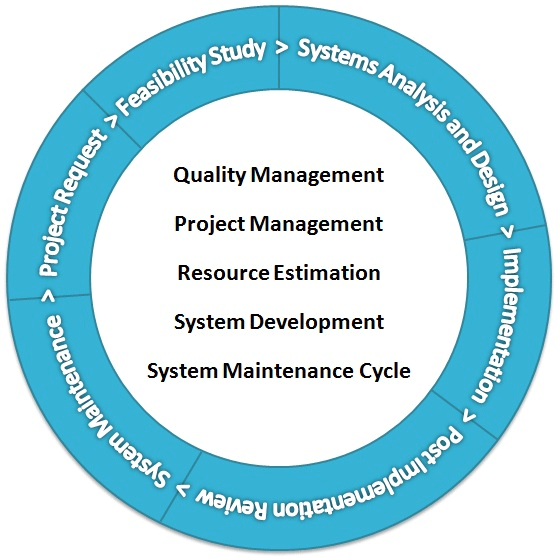Software Life Cycle
The Software Life Cycle Model provides a framework for the life cycle of an IT system from initiation, development to maintenance. In order to ensure the developed systems meet the business needs; work properly; are effectively developed and well maintained, standards and guidelines are essential throughout the whole Software Life Cycle.
The Software Life Cycle Model is depicted below. The model is composed of the System Development Cycle and the System Maintenance Cycle. The System Development Cycle covers a number of phases starting from Project Request, Feasibility Study, Systems Analysis and Design, Implementation and Post Implementation Review. The System Maintenance Cycle covers the System Maintenance phase. A comprehensive set of standards and guidelines has been established for supporting different activities of the whole Software Life Cycle including quality management, project management, resource estimation, system development, system maintenance, etc.

| Project Request To request for an IT solution, users should submit an Initial Request Statement (IRS). The IRS will be assessed and decision will be made on whether the project should proceed to the next phase or not |
| Feasibility Study To assess the feasibility of an IT solution and to quantify the requirements, scope, costs, benefits and other implications of the proposed solution |
| Systems Analysis and Design To investigate the existing system, to specify the new system, and to detail the implementation requirements by performing Systems Analysis and Logical System Design |
| Implementation To implement the findings of the SA&D by performing Physical System Design, Program Development, various kinds of testing, installation and Project Evaluation Review |
| Post Implementation Review To evaluate the cost-effectiveness of an implemented system and assess whether the system has achieved its agreed objectives and realized the intended benefits in a timely manner |
| System Maintenance To ensure the performance and functionality of the system match with the business needs of the users by on-going monitoring and maintenance |
Depending on the complexity and nature of the computerization project, project teams should have the flexibility in the adoption of the above standards and methodologies. If the standards and methodologies are adopted, the level of details and the extent of using them could be tailored to suit different project situations and needs. Besides, combined phases approach e.g. combined Feasibility Study / Systems Analysis & Design could be adopted.



